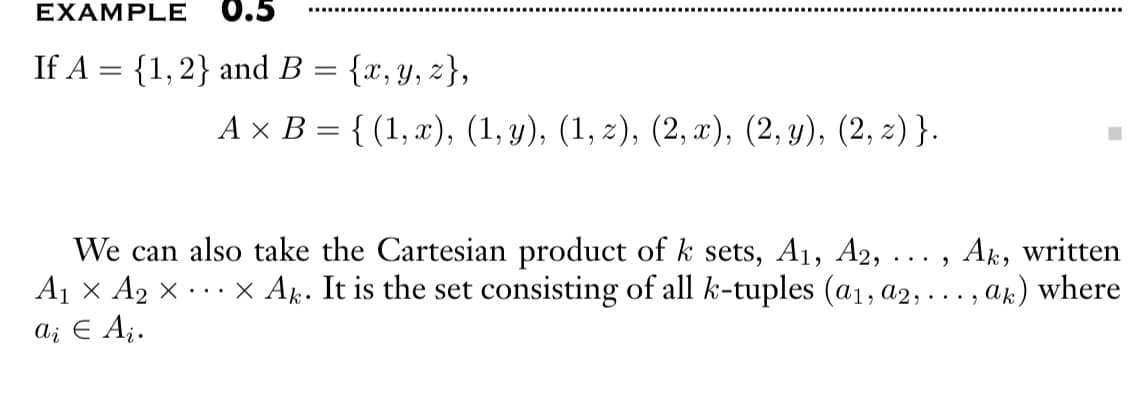EXAMPLE 0.5 If A = {1, 2} and B {x, y, z}, A × B = { (1,x), (1,y), (1, z), (2,x), (2, y), (2, z)}. = We can also take the Cartesian product of k sets, A₁, A2, Ak, written A₁ × A₂ X ... X A. It is the set consisting of all k-tuples (a₁, a2,..., ak) where ai € Ai.
EXAMPLE 0.5 If A = {1, 2} and B {x, y, z}, A × B = { (1,x), (1,y), (1, z), (2,x), (2, y), (2, z)}. = We can also take the Cartesian product of k sets, A₁, A2, Ak, written A₁ × A₂ X ... X A. It is the set consisting of all k-tuples (a₁, a2,..., ak) where ai € Ai.
Algebra & Trigonometry with Analytic Geometry
13th Edition
ISBN:9781133382119
Author:Swokowski
Publisher:Swokowski
Chapter3: Functions And Graphs
Section3.3: Lines
Problem 31E
Related questions
Question
Can you please help me with these two figures can you do this step by step and can explain it as well.
can you show the calculations step by step if they are any because I don't know

Transcribed Image Text:EXAMPLE 0.5
If A = {1, 2} and B
{x, y, z},
A × B = { (1,x), (1, y), (1, z), (2,x), (2, y), (2, z) }.
=
We can also take the Cartesian product of k sets, A₁, A2,
Ak, written
A₁ × A₂ × ... X Ak. It is the set consisting of all k-tuples (a₁, a2, ..., ak) where
a į € Ai.
Expert Solution
This question has been solved!
Explore an expertly crafted, step-by-step solution for a thorough understanding of key concepts.
Step by step
Solved in 3 steps with 1 images

Recommended textbooks for you

Algebra & Trigonometry with Analytic Geometry
Algebra
ISBN:
9781133382119
Author:
Swokowski
Publisher:
Cengage

Elementary Linear Algebra (MindTap Course List)
Algebra
ISBN:
9781305658004
Author:
Ron Larson
Publisher:
Cengage Learning

Algebra & Trigonometry with Analytic Geometry
Algebra
ISBN:
9781133382119
Author:
Swokowski
Publisher:
Cengage

Elementary Linear Algebra (MindTap Course List)
Algebra
ISBN:
9781305658004
Author:
Ron Larson
Publisher:
Cengage Learning